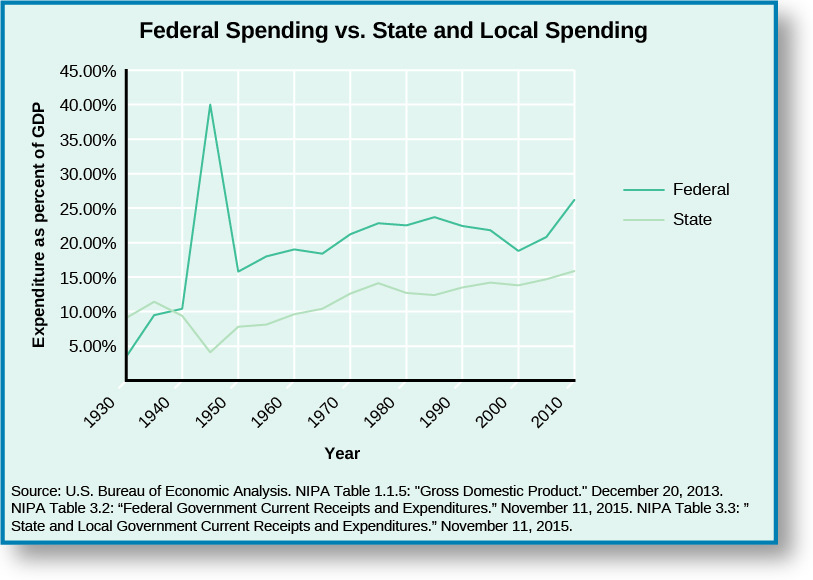| << Chapter < Page | Chapter >> Page > |
As the federal government’s role in policy creation expanded, so did its level of spending. Spending by the federal government began to surpass that of state and local governments shortly after 1940 ( [link] ). It spiked temporarily during the Great Depression and again during World War II, resuming a slow climb with the implementation of Johnson’s Great Society programs noted above.

Growing financial resources gave the federal government increased power over subnational governments. This increased power was because it could use categorical grants to dictate the terms and conditions state governments had to meet to qualify for financial assistance in a specific policy area. Over time, the federal government even began to require state and local governments to comply with legislative and executive authorizations when funding was not attached. These requests from the federal government are referred to as unfunded mandates and are a source of dissatisfaction to political actors at the state and local level. To provide more transparency to state and local governments and reduce the federal government’s use of mandates, the
Unfunded Mandates Reform Act was passed in 1995. This act requires the Congressional Budget Office to provide information about the cost of any proposed government mandate that exceeds a specified threshold before the bill can be considered in Congress.
Explore the latest news on federal mandates at the Congressional Budget Office and the Catalog of Cost Shifts to States at the National Conference of State Legislatures website.
Despite the national government’s power to pass and fund policy that affects lower-level governments, states still have gained considerable headway since the late twentieth century. For instance, with the passage of the
Personal Responsibility and Work Opportunity Reconciliation Act in 1996, known as the welfare reform bill, states were given great discretion over the provision of welfare. The federal government reduced its level of monetary support for the program and, in exchange, the states gained more authority over its implementation. States were able to set more restrictive work requirements, to place caps on the number of family members who could receive aid, and to limit the length of time someone could qualify for government assistance.
Since then, states have been granted the flexibility to set policy across a number of controversial policy areas. For instance, a wide array of states require parental consent for abortions performed on minors, set waiting periods before an abortion can be performed, or require patients to undergo an ultrasound before the procedure. As another example, currently, almost half the states allow for the use of medical marijuana and three states have fully legalized it, despite the fact that this practice stands in contradiction to federal law that prohibits the use and distribution of marijuana.

Notification Switch
Would you like to follow the 'American government' conversation and receive update notifications?